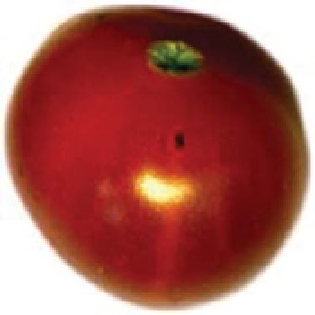Agriculture Reference
In-Depth Information
Human benefits
Essential nutrients
Antimicrobial activity
Antioxidant activity
Anticarcinogenic activity
Plant benefit
Seed distribution
Preferred
volatile
flavours
Ripening
3
Ex
En
4
WT
slcyp86a69
Plate 2.
Fruit aroma volatiles are both attractive to humans and indicators of ripeness (Goff, S.A. and Klee, H.J.
(2006) Plant volatile compounds: sensory cues for health and nutritional value?
Science
311(5762), 815-819).
Plate 3.
Expression of a
-glucuronidase (GUS) reporter driven by the tomato SlCER6 promoter region. GUS
expression is driven by the wax biosynthesis SlCER6 promoter and shows gene expression in the exocarp (Ex) and
endocarp (En) tissues in a tomato fruit slice, indicating the presence of the inner epidermal cuticular layer
(Mintz-Oron, S., Mandel, T., Rogachev, I., Feldberg, L., Lotan, O., Yativ, M., Wang, Z., Jetter, R., Venger, I., Adato,
A. and Aharon, A. (2008) Gene expression and metabolism in tomato fruit surface tissues.
Plant Physiology
147,
823-851).
Plate 4.
Responses of tomato fruit with depleted cuticle to fungal infection. Tomato fruit were inoculated with
Col-
letotrichum coccodes
conidia. Photographs taken at 5 days post-inoculation show that the wild type (WT) had neg-
ligible fungal growth, whilst the
slcyp86a69
mutant had developed a severe infection (Shi, J.X., Adato, A., Alkan,
N., He, Y., Lashbrooke, J., Matas, A.J., Meir, S., Malitsky, S., Isaacson, T., Prusky, D., Leshkowitz, D., Schreiber,
L.,
et al.
(2013) The tomato SlSHINE3 transcription factor regulates fruit cuticle formation and epidermal patterning.
New Phytology
197, 468-480).
β



Search WWH ::

Custom Search